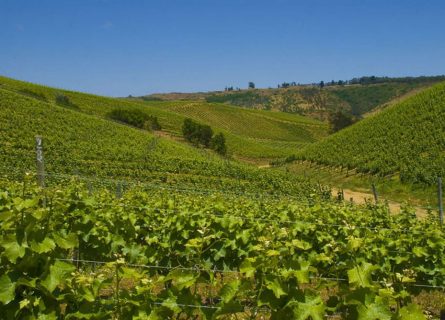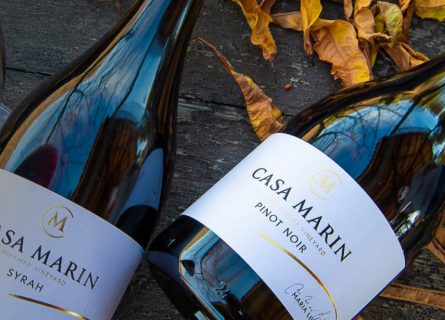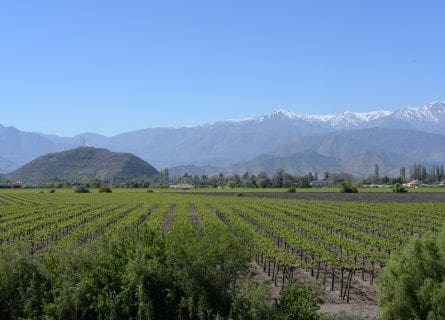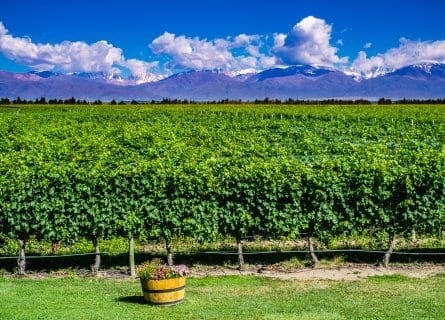San Antonio Valley Wine Region Guide
Chile's Cool Climate Conquest: Discover the Elegant Allure of San Antonio Valley Wines
EXPLORE ALL OUR GUIDES TO CHILE'S WINE REGIONS
Last updated: November 14, 2024
Introduction
First planted in the late 20th century, the San Antonio Valley in central-western Chile represents a new frontier in cool-climate winemaking. Pacific breezes, and exceptional soils yield some of the country’s finest Chardonnay and Pinot Noir. Initially developed by Viña Leyda in 1997, these rolling coastal hills are now carpeted in vines, driven by investment from Casa Marin, Matetic, and other pioneers.
In fewer than 30 years, it has become one of Chile’s most successful export regions, buoyed by a healthy demand for (affordable) alternatives to red and white Burgundy.
Yet, while San Antonio’s most obvious strengths are elegant Pinot and Chardonnay, investors are producing a fairly broad range of styles, including peppery Syrah, Sauvignon Blanc (a real triumph), lemon-scented Riesling, and even Gewurztraminer. The region has gone from strength to strength with a truly inspirational momentum.
Geography and terroir

It was Gustavo Llona, erstwhile owner of Viña Leyda, who first spotted the potential of this maritime-influenced vineyard. Working alongside the Fernandez family, Llona planted a few acres of Sauvignon Blanc and Chardonnay vines in an undulating region west of Santiago, some 90 kilometers from Chile’s dynamic capital. To the north is the Casablanca Valley, while the western border faces the Pacific Ocean. Because of the water’s proximity (less than 35 kilometers) and the welcome presence of brisk morning mists, Llona realized that cool-climate varietals would thrive here, not least the aforementioned Chardonnay and Pinot Noir.
Today, Viña Leyda is owned by the very capable San Pedro company, which also managesViña Tabalí. In the 21st century, they have been joined by an expanding firmament of eager investors, keen to exploit every advantage the valley offers. It says much for their skill and dedication, that San Antonio has developed rapidly over the past 15 years, earning great respect from critics and international buyers.
Recognition of Unique Terroirs
Indeed, there are now approximately 300 hectares under vine, planted in a beautiful landscape bordered by the coastal city of San Antonio to the west and the Casablanca Valley to the north. Meanwhile, in the southeastern corner of the zone, one will discover the Leyda Valley – another of Chile’s premier cool-climate terroirs. There is also the subregion of Lo Abarca to consider, a small enclave to the north of San Antonio. Located less than 5km from the Pacific, this very special terroir is renowned for its exceptionally cool growing environment; Casa Marin campaigned tirelessly for many years, arguing that Lo Abarca should not be subsumed into the San Antonio Valley DO. In 2018, Casa Marin won the argument.
As in Sonoma, the Pacific heavily influences the climatic conditions in the valley, responsible for cold morning fogs and chilly night-time breezes. And, unlike the Central Valley, the vineyards in the province of Aconcagua are directly exposed to the ocean, which delivers cool nights and outstanding quality fruit. Moreover, there is generally no rush to harvest grapes in San Antonio, as most rainfall occurs in winter. As a result, growers benefit from an extremely long growing season, with flavor and phenolic ripeness occurring at a moderate pace. This persistent marine influence, rather than altitude, produces such crystalline flavors in both dry whites and super-elegant reds. In cooler vintages, alcohol levels can often be lower than equivalent abv levels in the Côte-d’Or – the latter has experienced several torrid harvests over the past five years.
Cool-Climate Wines
Even in warmer years, however, wines from the region can showcase acidity levels that invoke the crisp texture and brilliant raciness of Mosel Riesling. Top climats (vineyard sites) are usually planted on the higher slopes, where intense sunlight and diurnal temperature variation combine to spectacular effect. The leading lights of the valley, particularly Leyda Syrah and Riesling, can be impressively long-lived.
Meanwhile, a specially constructed pipeline transports essential water from the Maipo River. The soils, too, are of exceptional quality: infertile outcrops of red clay on granite and some calcareous limestone. These well-drained terroirs, rich in minerals, suit both red and white varieties; such conditions encourage vines to send their root systems deep into the substratum in search of nutrients and moisture. Thus, excessive yields are rarely a major problem in the valley unless the plant receives abundant irrigation water. Spring frost, however, can lead to significant crop losses unless precautions are taken.
Winemaking and regional classifications

The Chilean attitude to winemaking can vary dramatically, ranging from the non-interventionist school to the sophisticated techniques used in the production of Maipo Cabernet. One example of the ‘hands-off’ approach is found in the cellars of Herrera Alvarado: owners Carolina Alvarado [] and Arturo Herrera take their inspiration from the natural winemakers of Europe, emphasizing the role of terroir while downplaying the value of ‘artificial’ inputs. Using fruit grown following biodynamic principles, a typical vinification will be undertaken without adding sulfur (normally used to prevent oxidation), fining, chemical additives, or filtration.
Cuero de Vaca
The bodega even produces a style made in cured cowhides, appropriately called Cuero de Vaca. The Carmenere bunches are carefully sorted in the cellar before they are fermented (using whole clusters) in cow skins with only natural yeasts – there is no temperature control or SO2. This potent concoction is then macerated on its skins for about 17 days and subsequently aged in neutral wood for 15 months.
Yet this rather heterodox perspective (notwithstanding Alvarado’s ingenuity) is not representative of the critical mass. For example, the winemaking team at Casa Marin endeavors to make a Pinot Noir that pays homage to the Grand Crus of Burgundy – they strive for fruit and finesse instead of power and strength. High alcohol, meanwhile, is almost seen as an embarrassment, however difficult it is to maintain (relatively) low abvs in warmer vintages.
Nevertheless, a small amount of sulfur is used to prevent spoilage, while temperature control aids in the extraction of ripe phenolics. Using top-quality fruit from the estate’s Litoral Vineyard, Casa Marin ferments a mixture of whole bunches and crushed berries in the vat, relying on wild yeast to kickstart the process in stainless steel tanks. An upper limit of 71.6°F ensures good extraction without burning out the fruity esters and flavors of the grape – a major risk when winemakers eschew any form of temperature control. After a series of daily manual punch downs, the wine is matured in used oak for 14 months.
Leading critic Tim Atkin MW awarded 95 points for the 2021 vintage, which he described as “elegant and refined,” offering aromas of “bright cherry and red fruits, with notes of fresh blueberry and a smoky touch.”
According to Casa Marin:
“The flavors are distinctive, underscored by firm acidity and a smooth texture. The palate showcases a well-structured profile with persistent red fruit flavors and a lingering, balanced finish.”
Our experience suggests that Leyda is one of Chile’s most exciting terroirs for producing Burgundy varietals, comparable to the elegance one detects in Sonoma and New Zealand. Yet, despite the undeniable hype surrounding Chilean Pinot, it is not our favorite delicacy from the San Antonio Valley.
The Rise of Riesling
That honor falls to Riesling. Imported in the 19th century, the signature grape of the Alsace region reaches an apogee in the clay-granite soils of San Antonio, where it yields a kind of perfumed essence that is spellbinding alongside Pacific cuisine. Intensely aromatic and intense, Riesling’s primary fruit (citrus and melon) uncoils after 5-7 years in bottle, revealing notes of honey, lightly browned toast, and the famous whiff of kerosene.
At Casa Marin, the aim is to produce a very expressive, fruity, and yet dry style. This process involves handling the juice protectively, gently pressing whole bunches to avoid skin contact, and fermenting the must in stainless steel tanks at precisely controlled temperatures (44-53ºF). A long, slow vinification on the fine lees at low temperatures adds texture and richness to the wine, bottled free of any oak influence. What emerges in your glass is a sublime concoction of fruit, acid, and alcohol. It is one of Chile’s greatest wine bargains, even if the world will pay a far higher price for barrel-aged Pinot Noir.
Facts & Figures
Key wine styles
- Medium-bodied red and white wines
Appellation structure
- DOs San Antonio Valley, Leyda Valley, Lo Abarca
Hectares under vine
- 2,073
Average annual production
- 20 million liters per annum (entire Aconcagua region)
Approximate number of producers
- 6 (other wineries based outside of the region source fruit from San Antonio Valley)
Key Grape Varietals
-
Chardonnay
Chardonnay is a green-skinned grape varietal native to the Burgundy wine region in France and one of the most popular varieties worldwide.
Find out more -
Sauvignon Blanc
The sauvignon blanc grape varietal, originally from the Bordeaux region of France, is now one of the world's most loved white varieties.
Find out more -
Sauvignon Gris
-
Riesling
Discover Riesling's charm, a white grape from Germany's Rhine region, cherished in Alsace, France. Unveil its secrets and delights
Find out more -
Cabernet Sauvignon
Discover the irresistible allure of Cabernet Sauvignon—a worldwide favorite with robust, dark-bodied flavor. Unleash your wine journey today!
Find out more -
Grenache
Discover grenache, a mediterranean grape that is dark-skinned red wine grape variety and an unlikely hero of a grape
Find out more -
Pinot Noir
Pinot noir is a light-bodied red wine varietal closely related to the Vitis vinifera grape and produces the most sought-after red wines in the world.
Find out more -
Syrah
Syrah is dark-skinned and perhaps the most underrated of the 'noble' red grape varieties.
Find out more
San Antonio Valley gastronomy
If you want to avoid the tourist hordes, head to the lively and likable port city of San Antonio. Granted, this is no Valparaiso – the architecture is unremarkable, and the city’s national monuments are few and far between. Yet it does offer a surprising collection of good restaurants, serving (and this will shock no one) fresh seafood that is often caught, sold, and cooked in fewer than five hours. Gambas al Ajillo and chilled Leyda Sauvignon Blanc would be our preference.
Wineries Recommended by Cellar Tours
-
Casa Marin
Casa Marin, led by Maria Luz Marin in Chile's San Antonio Valley, excels in cool-climate wines like Pinot Noir, winning 'Winery of the Year' accolades. Read more -
Cono Sur
Read more -
Vina Leyda
Read more -
Matetic
Read more -
Undurraga
Read more -
Vina Chocalan
Read more
Further Reading: Discover More Related Blog Content
More information
If you would like us to customize an exclusive luxury tour, contact us and let us know your travel plans. We offer luxury food and wine tours for private groups of a mininium two guests. In addition, all of our private, chauffeured tours are available year-round upon request.





